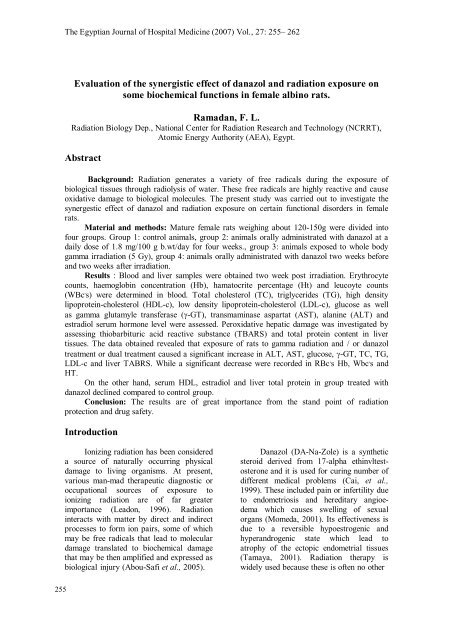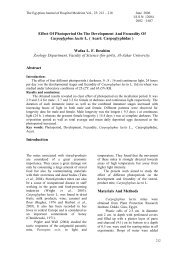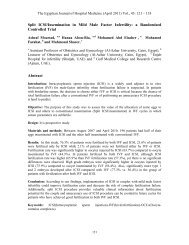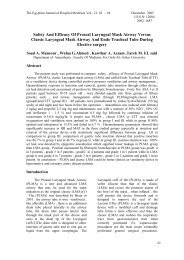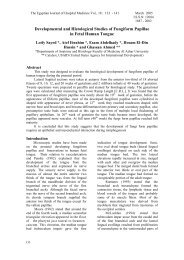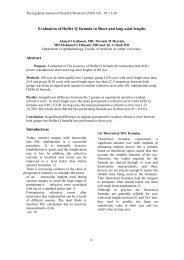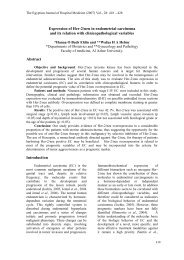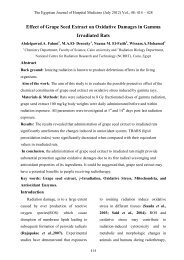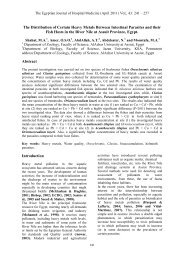Full Paper (vol.27 paper# 12) - Egyptian Journal Of Hospital Medicine
Full Paper (vol.27 paper# 12) - Egyptian Journal Of Hospital Medicine
Full Paper (vol.27 paper# 12) - Egyptian Journal Of Hospital Medicine
You also want an ePaper? Increase the reach of your titles
YUMPU automatically turns print PDFs into web optimized ePapers that Google loves.
The <strong>Egyptian</strong> <strong>Journal</strong> of <strong>Hospital</strong> <strong>Medicine</strong> (2007) Vol., 27: 255– 262<br />
Evaluation of the synergistic effect of danazol and radiation exposure on<br />
some biochemical functions in female albino rats.<br />
Ramadan, F. L.<br />
Radiation Biology Dep., National Center for Radiation Research and Technology (NCRRT),<br />
Atomic Energy Authority (AEA), Egypt.<br />
Abstract<br />
Background: Radiation generates a variety of free radicals during the exposure of<br />
biological tissues through radiolysis of water. These free radicals are highly reactive and cause<br />
oxidative damage to biological molecules. The present study was carried out to investigate the<br />
synergestic effect of danazol and radiation exposure on certain functional disorders in female<br />
rats.<br />
Material and methods: Mature female rats weighing about <strong>12</strong>0-150g were divided into<br />
four groups. Group 1: control animals, group 2: animals orally administrated with danazol at a<br />
daily dose of 1.8 mg/100 g b.wt/day for four weeks., group 3: animals exposed to whole body<br />
gamma irradiation (5 Gy), group 4: animals orally administrated with danazol two weeks before<br />
and two weeks after irradiation.<br />
Results : Blood and liver samples were obtained two week post irradiation. Erythrocyte<br />
counts, haemoglobin concentration (Hb), hamatocrite percentage (Ht) and leucoyte counts<br />
(WBc , s) were determined in blood. Total cholesterol (TC), triglycerides (TG), high density<br />
lipoprotein-cholesterol (HDL-c), low density lipoprotein-cholesterol (LDL-c), glucose as well<br />
as gamma glutamyle transferase (-GT), transmaminase aspartat (AST), alanine (ALT) and<br />
estradiol serum hormone level were assessed. Peroxidative hepatic damage was investigated by<br />
assessing thiobarbituric acid reactive substance (TBARS) and total protein content in liver<br />
tissues. The data obtained revealed that exposure of rats to gamma radiation and / or danazol<br />
treatment or dual treatment caused a significant increase in ALT, AST, glucose, -GT, TC, TG,<br />
LDL-c and liver TABRS. While a significant decrease were recorded in RBc , s Hb, Wbc , s and<br />
HT.<br />
On the other hand, serum HDL, estradiol and liver total protein in group treated with<br />
danazol declined compared to control group.<br />
Conclusion: The results are of great importance from the stand point of radiation<br />
protection and drug safety.<br />
Introduction<br />
Ionizing radiation has been considered<br />
a source of naturally occurring physical<br />
damage to living organisms. At present,<br />
various man-mad therapeutic diagnostic or<br />
occupational sources of exposure to<br />
ionizing radiation are of far greater<br />
importance (Leadon, 1996). Radiation<br />
interacts with matter by direct and indirect<br />
processes to form ion pairs, some of which<br />
may be free radicals that lead to molecular<br />
damage translated to biochemical damage<br />
that may be then amplified and expressed as<br />
biological injury (Abou-Safi et al., 2005).<br />
Danazol (DA-Na-Zole) is a synthetic<br />
steroid derived from 17-alpha ethinvltestosterone<br />
and it is used for curing number of<br />
different medical problems (Cai, et al.,<br />
1999). These included pain or infertility due<br />
to endometriosis and hereditary angioedema<br />
which causes swelling of sexual<br />
organs (Momeda, 2001). Its effectiveness is<br />
due to a reversible hypoestrogenic and<br />
hyperandrogenic state which lead to<br />
atrophy of the ectopic endometrial tissues<br />
(Tamaya, 2001). Radiation therapy is<br />
widely used because these is often no other<br />
255
Evaluation of the synergistic effect of danazol……..<br />
choice for treatment endometriosis in<br />
infertility female. Revelance, the steadily<br />
are gowing number of female workers<br />
integrating their activities with such kind of<br />
radiation exposure and / or therapy.<br />
In this respect, our study was carried<br />
out to study the synergistic effect of<br />
danazol and radiation exposure induced<br />
certain functional disorders in female albino<br />
rats.<br />
Material and Methods<br />
Mature female albino rats weighing<br />
<strong>12</strong>0-150g were obtained from the animal<br />
farm of the <strong>Egyptian</strong> Organization for<br />
Vaccine and Biological products. Rate were<br />
housed in cages and maintained under<br />
standard condition of ventilation,<br />
temperature and humidity. Food and water<br />
were available ad-libitum.<br />
Radiation facility:<br />
Irradiation was performed by Cesium-<br />
137 biological irradiation Gamma Cell-40<br />
belonging to the NCRRT, Nase City, Egypt.<br />
Irradiation dose (5Gy) was applied as a shot<br />
dose at a dose rate of 1Gy/1.2 min.<br />
Material:<br />
Danazol was purchased from<br />
SANDh1-Syinthelabo. Canada. It was<br />
dissolved in saline solution and orally<br />
administrated to rats at a dose of 1.8<br />
mg/100 kg b.wt/day for four weeks.<br />
Experimental design:<br />
Animals were divided into 4 groups<br />
each of 5 rats:<br />
1-Control group: Animals did not receive<br />
any treatment.<br />
2-Danazol group: Animal orally<br />
administrated with danazol at a dose of<br />
1.8 mg/100g b.wt/day all over the<br />
experiment (four weeks).<br />
3-Irradiated group: Animals irradiated at a<br />
dose of 5 Gy.<br />
4-Danazol and irradiated group: Animals<br />
treated with danazol two week pre and<br />
post irradiation (5 Gy).<br />
Biochemical Studies<br />
Five rats from each group were<br />
anaesthetized with ether and blood<br />
collected by heart puncture. Part of the<br />
blood was collected on EDTA for assay of<br />
RBc,s Ht and WBc,s Dacie and Lewis<br />
(1991), blood haemoglobin was assayed as<br />
cyanmethaemoglobin using Spectrum<br />
Diagnostic kit according to Teitz, (1994).<br />
The rest of blood was centrifuged to<br />
separate serum to determine glucose level<br />
according to Trinder, (1969) using Scico<br />
diagnosis kit. Aminotransaminases activity<br />
levels were determined as described by<br />
Reitman and Frankel (1957) by kit of<br />
plasmate laboratory LTd. Activity level of<br />
gamma glutamy transferase (-GT) was<br />
measured colorimetrically according to the<br />
procedure of Szasz and Persijn (1974).<br />
Also, estradiol was determined by using<br />
Radioimmunoassay RIA technique<br />
(Diagnostic products corporation, Los<br />
Angeles, USA). Total cholesterol, high<br />
density lipoprotein cholesterol, low density<br />
lipoprotein cholesterol and triaglycrides<br />
were assayed in serum according to the<br />
method of Allan et al., (1974), Demacer et<br />
al., (1980), Friedewald et al. (1972) and<br />
Fossati and Prencipe (1982) respectively.<br />
Liver were excised and weighed then<br />
homogenized to determine total protein<br />
according to Lowry et al. (1951). Lipid<br />
peroxidation in liver tissue was ascertained<br />
by the formation of TBARS and measured<br />
as described by Yoshioka et al. (1979).<br />
Statistical analysis of data were performed<br />
using student t-test (Snedector and Cochron<br />
1989).<br />
Results<br />
In the present study, experimental<br />
animals received danazol for 4 weeks at a<br />
dose equivalent to 1.8 mg/100 g b.wt/day<br />
and / or exposed to gamma radiation (5 Gy)<br />
exerted a significant decrease in RBc,s Hb,<br />
WBc,s Ht and HDL-c (P ≤ 0.001) as<br />
compared to control group table (1 and 2).<br />
Table (3) indicated that whole body gamma<br />
irradiation (5 Gy) induced a significant<br />
increase in serum estradiol levels whereas<br />
treatment with danazol induced a<br />
significant decrease in the serum estradiol<br />
(P < 0.001) as compared with control.<br />
Meanwhile, the tested treatment<br />
combination with danazol and radiation<br />
exhibited a tendency to decrease serum<br />
256
Ramadan, F. L.<br />
estradiol as compared to irradiated group.<br />
On the contrary, danazol administration and<br />
/ or exposure to gamma radiation showed a<br />
significant elevation in serum TC, TG,<br />
LDL-c, glucose level, AST, ALT and -GT<br />
activity (P
Evaluation of the synergistic effect of danazol……..<br />
Table (4): Effect of danazol administration to irradiated female rats on thiobarbituric acid<br />
reactive substance (TBARS), total protein content in liver tissue.<br />
Groups<br />
Parameter<br />
TBARS<br />
(m mol/g tissue)<br />
Control 371 21.51 0.51 0.020<br />
Danazol 425 1.78 ** 0.42 0.028 **<br />
-irradiation 492 8.746 *** 0.40 0.017 ***<br />
Danazol + -radiation 509 5.586 *** 0.36 0.016 ***<br />
Leganed as Table (1).<br />
Discussion<br />
Total protein<br />
(g/g tissue)<br />
In the present work, the results<br />
revealed that whole body gamma irradiation<br />
(5 Gy) or / and danazol administration at a<br />
dose of 1.8 mg/100 g b.wt/day produced<br />
haematological disorders. This was evident<br />
from the significant decrease in RBc,s<br />
remarkable fall in Hb concentrations,<br />
significant drop in HT percentage and<br />
significant decrease in total WBC,s. The<br />
decrease in erythrocyte counts could be due<br />
to a drop in their production, increased<br />
destruction and / or haemorrhage due to the<br />
failure of thrombopoiesis. Our results are in<br />
complete harmony with those of (Hussein<br />
et al.. 2007, Ashry, 2003 and Lee and<br />
Ducoff 1994). Radiation damage of<br />
haemoglobin is considered as one of the<br />
most important mechanisms triggering<br />
radiation sickness (Kurbanov et al., 1995).<br />
The decrease in Hb content (HT %) due to<br />
the radiation induced changes in<br />
erythrocyte membrane emphasizes the<br />
formation of free radicals. The effect of free<br />
radicals on erythrocyte membrane may<br />
contribute to the eventual leak of<br />
haemoglobin out of the cells (Hussein et al.,<br />
2007). Irradiation of rats caused retardation<br />
in incorporation of iron and decrease in<br />
haemoglobin binding to erythrocyte<br />
membrane. This finding agree with that<br />
observed by Tanikawa et al. (1990).<br />
Leucocytes are highly radiosensitive<br />
to radiation and are considered as a<br />
sensitive biological indicator for the<br />
diagnosis of radiation injures (Moss et al.,<br />
1979). In the present study, the reduction in<br />
total leucocytes count (leucopenia) after<br />
irradiation of animals could be attributed to<br />
mitotic inhibition of the bone marrow<br />
precursors (Hassan et al., 1996). On the<br />
other hand, danazol caused impairment in<br />
immune system which may has resulted in a<br />
defect in the ability to remove debris in the<br />
perutoneum and lacke of serum-soluble<br />
human leukocyte antigen which lead to<br />
hemolytic anemia (Moen et al., 1984). The<br />
present results demonstrated that exposure<br />
of animals to gamma radiation and / or<br />
danazol treatment showed a significant<br />
elevation in serum cholesterol, triglycride,<br />
low density lipoprotein and a decrease in<br />
high density lipoprotein. These data are in<br />
accordance with previous results of Ragab<br />
and Ashry 2004, and Abou Safi et al., 2005<br />
who observed that the elevation in serum<br />
lipid fractions might result from ionizing<br />
radiation ability to accelerate other<br />
pathways of cholesterol formation like<br />
increasing its rate of biosynthesis in the<br />
liver and other tissues, or destruction of cell<br />
membrane by radiation and also to<br />
disturbance LDL cholesterol recepetors,<br />
leading to hypercholesterolemia which<br />
affect particularly on polyunsaturated fatty<br />
acids and increase lipid peroxidation<br />
Kolomigseva, 1986 and Karbownik and<br />
Reiter 2000. On the other hand, danazol<br />
administration indicated that VLDL was<br />
catabolized and converted to LDL while the<br />
formation of HDL was impaired due to low<br />
activity of apoprotein A and B (Fukuda and<br />
Tamura 1987). The recorded consequently<br />
elevated level of triglycerides correlates<br />
previous finding of Osman, (1996) and<br />
Abou-Safi et al. (1999), who observed that<br />
after irradiation insulin level increased and<br />
synthesis of triglycerides was increased in<br />
both adipose tissues and liver which was<br />
accompanied by an acceleration of fatty<br />
acids mobilization from fat dopots to blood.<br />
258
Ramadan, F. L.<br />
Moreover, Ellefson and Caraway (1976)<br />
stated that hyperglyceridemia may be<br />
caused by metabolic disorder as a result of<br />
endocrine dysfunction and increased level<br />
of glucose. The recorded hyperglycemia in<br />
our results could be attributed to endocrine<br />
abnormalities induced by irradiation that<br />
promote the secretion of peptide which has<br />
relation to carbohydrate metabolism by<br />
increasing glyconeogenesis in liver<br />
(Darwish et al., 2007).<br />
Results of the present investigation<br />
showed that irradiation (5 Gy) of female<br />
rats or treatment with danazol induced<br />
disturbance in the secretory activity of the<br />
ovaries. Such effect was manifested by the<br />
significant increase in serum estradiol level<br />
after exposure of rats to gamma radiation.<br />
These observation were similar to those<br />
described by Banetskay and Amvrosev<br />
(1995) who indicated that marked<br />
stimulation of the ovulation was detected at<br />
once after irradiation, which can be<br />
connected with changes of the hormonal<br />
balance in animal body and also increased<br />
number of atretic follicles as a result of<br />
production of free radicals which induce<br />
cellular changes (Hassan and Abou-Safi<br />
1998). Therefore, the lower penetration of<br />
hormones in a tissue target leads to its<br />
accumulation in blood (Ramadan and Rezk<br />
2004). The decrease in serum steroid<br />
hormones (estradiol) after treatment of rats<br />
with danazol could attributed to danazol<br />
effect on ovarian and anterior pituitary<br />
gland which lead to an increase in<br />
androgenic activity (Fedele et al., 1993 and<br />
Liu et al, 1998). Furthermore, Meldrum et<br />
al. (1983) observed that sex hormone<br />
binding globulin was markedly suppressed<br />
throughout danazol treatment resulting in<br />
elevation of testosterone and decrease<br />
esterogen level. Our results manifested a<br />
significant increase in ALT, AST and GGT<br />
activities after exposure of rats to gamma<br />
radiation or danazol administration. GGT<br />
activity is considered to be one of the best<br />
indicators of liver damage since it is<br />
embedded in the hepatocytes plasma<br />
membrane and the libration of this enzyme<br />
to sera levels damage to the cell and then<br />
injury of the liver, which lead to increase in<br />
lipid peroxides (Muriel et al., 1992 and<br />
Gharib, 2007). The present data further<br />
demonstrated a significant increase in<br />
serum transaminase activity in all<br />
experimental groups. This conclusion agree<br />
with that found by (Abdel-Gawad and<br />
Ahmed 2005). The increased levels of AST<br />
and ALT could be referred to the drastic<br />
dysfunction of the liver cells induced by<br />
radiation interaction with cellular<br />
membranes and also related to extensive<br />
breakdown of liver parenchyma (Kafafy<br />
2000). However, the increase in TBARS<br />
might be explained on the basis that<br />
exposure of female rats to ionizing<br />
radiation increased the amount of free<br />
radicals in the body especially potent<br />
hydroxyl radicals (OH) attack the<br />
polyunsaturated fatty acids in the<br />
phospholipids portion of cell membranes<br />
initiating the lipid peroxidation chain<br />
reaction (Darwish et al., 2007). Moreover,<br />
also danazol caused cytotoxicity for cell<br />
which causes elevation of lipid peroxidation<br />
(Stevenson et al., 2000). The registered<br />
decrease in total protein content of liver<br />
tissue could be similar to other findings of<br />
(Azab, 1996 and Abou Safi et al., 2005)<br />
who reported that radiation could induce<br />
variety of membrane changes including<br />
lipid peroxidation and amino acid damage<br />
in membrane proteins.<br />
On the other hand, danazol treatment<br />
interfered with the function of liver which<br />
lead to severe anemia and it caused hepatic<br />
failure (Holt and Keller 1984). In addition,<br />
the treatment of animals with danazol was<br />
related to the decline in Ca ++ ion<br />
concentration which lead to decrease total<br />
protein (Kriplani et al., 1998).<br />
According to the present results it<br />
could be concluded that radiation exposure<br />
or / danazol intake could exert a deleterious<br />
biological effect. Therefore, it is<br />
recommend that radiation occupational<br />
workers especially females have to be<br />
carful toward danazol intake.<br />
References<br />
1. Abdel Gawad I I and Ahmed A M<br />
(2005): Lipid peroxidation and electrolyte<br />
irradiated rats treated with caffeine. Egypt.<br />
J. Rad. Sci, Appl., 18 (1):6-<strong>12</strong>.<br />
2. Abou-Safi H M, Ashry O M and Kafafy<br />
Y A (2005): Effect of N-acetyl-L-cysteine<br />
and -tocopherol administration on<br />
endogenous antioxidant protection of liver<br />
259
Evaluation of the synergistic effect of danazol……..<br />
DNA and RNA and plasma lipid profile in<br />
-irradiated rats. Egypt. J. Sci. Applc.<br />
Vol.18, No. 1 pp.81-96.<br />
3. Abou-Safi H M, Hussein A H and El-<br />
Sayed N M (1999): Efficacy of vitamins A<br />
and / or E as antioxidants against serum<br />
glucose, liver glycogen and lipid<br />
discrepancy induced by gamma radiation<br />
during the estrus cycle of rats. Egypt. J.<br />
Rad. Sci. Applic. Vol. <strong>12</strong>, No.2. pp. 1-146.<br />
4. Allan R and Roxon J (1974): Metabolism<br />
by intestinal bacteria: The effect of bile<br />
salts on tartrazine azo reduction.<br />
Xenobiotica, 4: 637-647.<br />
5. Ashry O (2003): Modulation of radiation<br />
induced toxicity by caffeine preinjection in<br />
female rats. Egypt. J. Rad. Sci. Applic., 16<br />
(1): 1-11.<br />
6. Azab K S M (1996): Response of certain<br />
biochemical parameters to whole body<br />
gamma irradiation in albino rats and<br />
synergistic effect of Pharmacological agent.<br />
Ph.D. Thesis, Faculty of Science of<br />
Alexandria Univ. Egypt.<br />
7. Banetskay and Amvrosev (1995): Clinical<br />
and experimental study on the treatment of<br />
endometriosis with dan , e mixture.<br />
Zhonigguo Zhong Xi Yl 19 (3): 159-220.<br />
8. Cai L, Shu Y and Xie H (1999): Clinical<br />
and experimental study on the treatment of<br />
endometriosis with dan a mixture.<br />
Zhongguo Zhong Xi Yi Jie the Za Zhi, 19<br />
(3): 159-161.<br />
9. Dacie S T and Lewis S M (1991):<br />
Practical haematology. 7 th ed. Churchill,<br />
Levingston. Medical Division of Longman<br />
Group. UK. LTd.<br />
10. Darwish M M, Hussien E M and Haggag<br />
A M (2007): Possible role of licorice roots<br />
(glycyrrhiza glabra) as a natural<br />
radioprotector against oxidative damage in<br />
rats. Egypt. J. Rad. Sci. Applic., Vol, 20,<br />
No. (1): 95-108.<br />
11. Demacer P N M, Nasjanssen H E Hifmas<br />
A G M, Vant , s Lear A and Jansen A P<br />
(1980): Measurement of high density<br />
lipoprotein cholesterol in serum comparison<br />
of sex isolation methods combined with<br />
enzymatic cholesterol analysis. Clin. Chem.<br />
26 (13): 178-186.<br />
<strong>12</strong>. Ellefson R D and Caraway W T (1976):<br />
Lipids and lipoproteins In: Fundamentals in<br />
clinical chemistry edated by Tietz, N. pp.<br />
474-541.<br />
13. Fedele, L,Marchini M,Bianchi S and<br />
Zanotti F (1993): Vaginal patterns during<br />
danazol and buserelin acetate therapy for<br />
endometriosis: Structural and<br />
Ultrastructural study. Fertil Steril; 59 (6):<br />
1191-1196.<br />
14. Fossati P and Prencipe L (1982): Serum<br />
triglyceride determined colourimetrically<br />
with an enzyme that produce hydrogen<br />
peroxide. Clin. Chem. 28, 2077.<br />
15. Friedewald W T , Levy R I and<br />
Fredrickson D (1972): Estimation of<br />
concentration of low-density lipoprotein<br />
cholesterol in plasma without use of the<br />
preparative ultracentrifuge. Clin. Chem., 18<br />
(6): 499.<br />
16. Fukuda Y and Tamura S (1987): Effects<br />
of danazol on serum lipd and lipoprotein<br />
levels in patients with endometriosis.<br />
Nippon Sanka Fujinka Gakkai Zasshi., 39<br />
(6): 980-986.<br />
17. Gharib O A (2007): Does kombucha tea<br />
reduce the damage induced by radiation<br />
exposure. Egypt. J. Rad. Sci, Applic., Vol<br />
20, 1, 141-157.<br />
18. Hassan S, Abu-Gahadeer A and Osman<br />
S (1996): Vitamins B group and / or folic<br />
acid restoring the haematopoieic activity in<br />
irradiated rats. Egypt. J. Rad. Sci. Applic., 9<br />
(1): 67-78.<br />
19. Hassan S H and Abu-Safi H M (1998):<br />
Prophylatic and therapeutic role of<br />
combined treatment with vitamin A and B<br />
group for restoration of ovarian hormones<br />
level in irradiated rats. J. Egypt. Ger. Soc.<br />
Zool. Vol. 25 (A) 89-104.<br />
20. Holt A P Sr and Keller D (1984): Danazol<br />
treatment increase serum enzyme levels.<br />
Fertil Steril; 41 (1): 70-74.<br />
21. Hussien E M, Darwish M M and Ali S E<br />
(2007): Prophylactic role of combined<br />
treatment with Coenzyme Q 10 and<br />
Vitamin E against radiation in male rats.<br />
Egypt. J. Rad. Sci. Applic., vol 20, 1. 181-<br />
194.<br />
22. Kafafy Y (2000): Protective effect of<br />
cytoeime and vitamin E on gamma<br />
irradiation injury in rats. Egypt. J. Rad. Sci.<br />
Applic., 13 (2): 17-25.<br />
23. Karbownik M and Reiter R S (2000):<br />
Antioxidantative effects of melatonin in<br />
protection against cellular damage caused<br />
by ionizing radiation. Proc. Soc. Exp. Biol.<br />
Med. 225 (1): 9-16.<br />
24. Kolomigtseva I K (1986): Activation of<br />
chelosterologensis under the effect of<br />
ionizing radiation mammalin body.<br />
Radiobiologiya, 26 (1): 3.<br />
25. Kriplani A, Nath A, Takkar D and<br />
Maya, Kaul H L (1998): Biochemical<br />
hemodynamic and hematological changes<br />
during transcervical resection of the<br />
endometrium using 1.5% glycin as the<br />
irrigating solution. Eur, A. obstet. Gynecol.<br />
Repord Biol., 80 (1): 99-104.<br />
26. Kurbanov F F, Mamedov T C, Abdullaev<br />
260
Ramadan, F. L.<br />
Kh D and Manoilov S K (1995): A<br />
quantitative analysis of haemoglobin<br />
composition structure and properties under<br />
the action of radiation in vivo consutions.<br />
Rad. Biol. Radioecol., 35 (2): 200-210.<br />
27. Leadon S A (1996): Repair of DNA<br />
damage produced by ionizing radiation. A<br />
mini review Seminars in radiation.<br />
Oncology, Univ. North Carolina, USA., 6<br />
(4): 295-305.<br />
28. Lee S W and Ducoff J S (1994): The<br />
effects of ionizing radiation on avian<br />
erythrocytes. Rad. Res., 137 (1): 104-110.<br />
29. Liu, J.; Li, X. and Hu, X. (1998): Clinical<br />
observation on treatment of endometriosis<br />
by tonifying kidney and removing blood<br />
stasis. Suzhou Maternity and Infant health<br />
Institute 18 (3): 145-152.<br />
30. Lowry O H, Rosebrough N I, Farr A L<br />
and Randall R J (1951): Protein<br />
measurement with folin phenol reagent. J.<br />
Biol. Chem.., 193, 265.<br />
31. Meldrum D R, Paradridge W M, Rivier<br />
J, Vale W and Judd H L (1983):<br />
Hormonal effects of danazol and medical<br />
oophorectomy in endrometriosis. Obstet<br />
Gynecol. 62 (4): 480-485.<br />
32. Moen M, Bratli A and Moen T (1984):<br />
Distribution of HLA antigens among<br />
patients with endometricosis. Acta obstet<br />
Gynecol Scand <strong>12</strong>3: 25-27.<br />
33. Momoeda M (2001): Strategy of treatment<br />
for infertile women with endometriosis.<br />
Nippon Rinsho, 59 (1): 172-178.<br />
34. Moss W, Brand W and Bellifara H<br />
(1979): In: The Hematopietic Tissue. 5 th ed.<br />
Rad. Com. Toronto-London, p 59.<br />
35. Muriel P, Garciapina T, Perez-Alvarez V<br />
and Mourelle M (1992): Silymarin<br />
protects against paracetamol-induced lipid<br />
peroxidation and liver damage. J. Appl.<br />
Toxicol., <strong>12</strong> (6): 439-448.<br />
36. Osman S A A (1996): Melatonin beosting<br />
antioxidant capacity for effective radiation<br />
protection in albino rat. Egypt. J. Med. Sci.,<br />
17 (2): 281-295.<br />
37. Ragab E A and Ashry O M (2004): Lipid<br />
and carbohydrate metabolism in rats.<br />
Egypt. J. Rad. Sci. Applic, Vol. 17, N (2)<br />
pp. 403-414.<br />
38. Ramadan F L and Rezk R G (2004):<br />
Evening primrose oil attenuates certain<br />
radiation induced functional and structural<br />
disorders in female rats. The <strong>Egyptian</strong> J. of<br />
Hosp. Med. Vol., 16: 119-131.<br />
39. Reitman S and Frankel S (1957): A<br />
colourimetric method for the determination<br />
of serum glutamic oxaloacetic and glutamic<br />
pyruvic transaminases. Am. J. Clin. Path,<br />
28: 57-66.<br />
40. Reitz N. (1994): Text Book of clinical<br />
Chemistry. 3nd ed., Saunders Company:<br />
1997 and 521.<br />
41. Snedecor G W and Cochron W G (1989):<br />
Statistical Methods, 8 th ed., Lowis state<br />
Univ. Press. Ames Lowa USA.<br />
42. Stevenson A F, Xing X. and Kunstmann<br />
P (2000): Study of growth the features and<br />
fertility effect after danzol / hormonal<br />
therapy. J. Exp. Biol., 33 (<strong>12</strong>): 1192-<strong>12</strong>00.<br />
43. Szasz G, Persihn J P (1974): Alklin.<br />
Chem. Klin. Biochem, <strong>12</strong>: 228, C. F. Pointe<br />
Scientific Inc., Lincoin Park, Muchigon,<br />
USA.<br />
44. Tamaya T (2001): Danazol up to date<br />
aspect for endometriosis. Nippon Rinsho, 1:<br />
139-188.<br />
45. Tanikawa S, Nose M, Aoki Y, Tsuneoka<br />
K and Vara N (1990): Effects of<br />
recombinant human granulocyte colonystimulating<br />
factor on the hematologic<br />
recovery and survival of irradiated mice.<br />
Blood, 76 (3): 445.<br />
46. Trinder P (1969): Ann. Clin. Biochem. 6:<br />
24 CF/Biomerieux Comp. France.<br />
47. Yoshioka T, Kawada K, Shimada T and<br />
Mori M (1979): Lipid peroxidation in<br />
maternal cord blood and protective<br />
mechanism against activated-oxygen<br />
toxicity in the blood. Am. J. Obstet.<br />
Gynecol., 135 (3): 372.<br />
261
Evaluation of the synergistic effect of danazol……..<br />
تقييم التأثيراث المؤازرة للدانسول والتعرض اإلشعاعى على بعض الوظائف<br />
الحيويت<br />
فى إناث الجرذان البيضاء<br />
فاطمت لطفى رمضان<br />
قسى بحىث انبيىنىجيب اإلشعبعية انًسكص انقىيً نبحىث وتكُىنىجيب اإلشعبع<br />
هيئة انطبقة انرزية جًهىزية يصس انعسبية<br />
يىنّد اإلشعبع أَىاعب يختهفة ينٍ انونىازا انحنسث أحُنبر تعنسس ا َسن ة هينج تسنهى<br />
هرِ انوىازا انُوطة فً تدييس انخاليب. أستهدف هرا انبحج ازاسة انتأحيس انًنااشز نهتنأحيسا<br />
انبيىنىجية انُبت ة عٍ اإلشعبع وانًعبيهة ببنداَصول عهً إَبث ان سذاٌ انبيضبر. وقند قسنً<br />
إَننبث ان ننسذاٌ إنننً أزبعننة ي ننبيي أل انً ًىعننة ا ونننً أسننتخدي كً ًىعننة ننببطة أل<br />
انً ًىعة انخبَية ت سع ببنداَصول نًندث أزبعنة أسنببي بًقنداز يه نى نكنم<br />
يٍ وشٌ ان سى يىييب( أل وانً ًىعة انخبنخة تى تعسيضنهب كهينب نعشنعبع ان نبيً ب سعنة كهينة<br />
يقندازهب جنساي وانً ًىعنة انسابعنة ت سعن َفنا جسعنة اننداَصول نًندث أسنبىعيٍ قبنم<br />
انتعننسس نه سعننة اإلشننعبعية ونًنندث أسننبىعيٍ بعنند انتعننسس نعشننعبع. بُهبيننة<br />
انت سبة تى سحب عيُب يٍ اندو وَسيج انكبد بعد أسبىعيٍ يٍ انتعسس نعشعبع.<br />
أظهننس َتننبلج اندزاسننة أٌ انتعننسس نعشننعبع أو انًعبيهننة ببنننداَصول أو انًعبيهننة<br />
انًصاوجنة ببإلشنعبع واننداَصول قند تسنبب فنً شينباث يعُىينة فنً كنال ينٍ يسنتىي ان هىكنىش<br />
وَونب إَصيًنب تنساَا أييُينص ا نُنيٍ وتنساَا أييُينص ا سنبستي أل انكىنيسنتيسول انكهنً أل<br />
انكىنيسننتيسول يننُخفك انكخبفننة أل اننندهىٌ انخالحيننة أل إَننصيى ان بيبجهىتبييننم تساَسننفيسيص فننً<br />
انسيسو وكرنك انًىاا انًتفبعهة ي هًك انخيىبسبتيىزيك فً َسيج انكبد بيًُب سبب انتعسس<br />
نعشننعبع أو انًعبيهننة ببنننداَصول أو اإلحُننيٍ يعننب إنننً إَخفب ننب يعُىيننب فننً عنندا كننسا اننندو<br />
انحًسار وانبيضبر أل انهيًىجهىبيٍ أل انهيًبتىكسي أل انكىنيستيسول انعبنً انكخبفة فً انسنيسو<br />
وأيضنب هسينىٌ ا سنتساايىل نهً ًىعنة انًعبيهنة ببننداَصول ببإل نبفة إننً هندوث إَخفب نب<br />
يعُىيب فً يحتىي انبسوتيٍ انكهً فً أَس ة انكبد.<br />
وتستخهص يٍ هرِ انُتبلج عهً سوزث إسنتعًبل اننداَصول بحنرز نعَنبث انعنبيهيٍ<br />
فً ي بل اإلشعبع.<br />
811 جنساو<br />
8.1(<br />
)5 جننساي(<br />
5<br />
262


